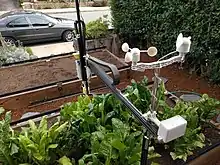Open-source robotics
Open-source robotics is a branch of robotics where robots are developed with open-source hardware and free and open-source software, publicly sharing blueprints, schematics, and source code. The term usually means that information about the hardware is easily discerned, so that others can make it from standard commodity components and tools. It is thus closely related to the open design movement, the maker movement[1] and open science.

Popularity
A first sign of the increasing popularity of building robots yourself can be found with the DIY community. What began with small competitions for remote operated vehicles (e.g. Robot combat), soon developed to the building of autonomous telepresence robots as Sparky and then true robots (being able to take decisions themselves) as the Open Automaton Project. Certain commercial companies now also produce kits for making simple robots.
A recurring problem in the community has been projects, especially on Kickstarter, promising to fully open-source their hardware and then reneging on this promise once funded, in order to profit from being the sole manufacturer and seller.
Applications
Popular applications to date include:
- Laboratory robotics (various applications)
- Domestic tasks: vacuum cleaning, floor washing and automated mowing.[2][3]
- combat robots, including manual controlled and autonomous contests
- Education[4]
- 3D photogrammetry[5]
Examples
This is a non-exhaustive list of open source robots:
- Quad-SDK for large agile four-legged robots (compatible with the ROS),[6][7][8] and the quadcopter-drone system Agilicious[9][10]
- Robot Operating System (ROS or ros) is an open-source robotics middleware suite.
See also
References
- Gibb, Alicia (2015). Building Open Source Hardware: DIY Manufacturing for Hackers and Makers. New York. pp. 253–277.
{{cite book}}: CS1 maint: location missing publisher (link) - "DIY commercial vacuum robot". The Red Ferret Journal. 30 October 2007. Retrieved 13 September 2014.
- "DIY Roomba preposition on Arduino motherboard". Archived from the original on 3 December 2010. Retrieved 13 September 2014.
- Vrochidou, Eleni; Manios, Michail; Papakostas, George A.; Aitsidis, Charalabos N.; Panagiotopoulos, Fotis (September 2018). "Open-Source Robotics: Investigation on Existing Platforms and Their Application in Education". 2018 26th International Conference on Software, Telecommunications and Computer Networks (SoftCOM). pp. 1–6. doi:10.23919/SOFTCOM.2018.8555860. ISBN 978-9-5329-0087-3. S2CID 54438146.
- Jensen, Austin M.; Morgan, Daniel; Chen, YangQuan; Clemens, Shannon; Hardy, Thomas (1 January 2009). "Using Multiple Open-Source Low-Cost Unmanned Aerial Vehicles (UAV) for 3D Photogrammetry and Distributed Wind Measurement". Volume 3: ASME/IEEE 2009 International Conference on Mechatronic and Embedded Systems and Applications; 20th Reliability, Stress Analysis, and Failure Prevention Conference. pp. 629–634. doi:10.1115/DETC2009-87586. ISBN 978-0-7918-4900-2.
- Verrengia, Giordana. "Open-source software gives a leg up to robot research". Carnegie Mellon University Mechanical Engineering via techxplore.com. Retrieved 18 September 2022.
- "Video Friday: Grip Anything". IEEE Spectrum. 29 July 2022. Retrieved 18 September 2022.
- Norby, Joseph; Yang, Yanhao; Tajbakhsh, Ardalan; Ren, Jiming; Yim, Justin K.; Stutt, Alexandra; Yu, Qishun; Flowers, Nikolai; Johnson, Aaron M. (May 2022). "Quad-SDK: Full Stack Software Framework for Agile Quadrupedal Locomotion" (PDF). Retrieved 18 September 2022.
- Yirka, Bob. "Open-source and open hardware autonomous quadrotor flies fast and avoids obstacles". techxplore.com. Retrieved 20 July 2022.
- Foehn, Philipp; Kaufmann, Elia; Romero, Angel; Penicka, Robert; Sun, Sihao; Bauersfeld, Leonard; Laengle, Thomas; Cioffi, Giovanni; Song, Yunlong; Loquercio, Antonio; Scaramuzza, Davide (22 June 2022). "Agilicious: Open-source and open-hardware agile quadrotor for vision-based flight". Science Robotics. 7 (67): eabl6259. arXiv:2307.06100. doi:10.1126/scirobotics.abl6259. ISSN 2470-9476. PMID 35731886. S2CID 249955269.

